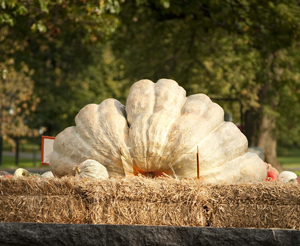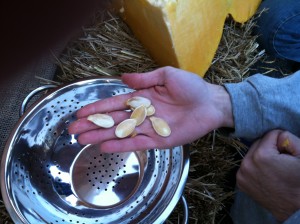Not Your Average Pumpkin
Posted in Gardening Tips on November 1 2011, by Sonia Uyterhoeven

For the past two weekends, The New York Botanical Garden has been abuzz with the return of the giant pumpkins. We had four mega pumpkins shipped in from different parts of the U.S. and Canada. Their weight ranged from 1,693 to 1,818.5 lbs. With colors ranging from a cheerful orange hue to pale orange, green, and silver gray, it made for a fascinating variety of size and color.
They were all reclining on multiple bales of hay like Ingres’s Odalisque in a somewhat regal and enticing fashion, surrounded by a harem of smaller heirloom pumpkins and gourds.
Before the exhibition opened, I arrived early one morning to see the pumpkin aficionados carve an opening in the back of the pumpkin and carefully remove all the seeds. De-seeding the pumpkins is an integral part of the process. Not surprisingly, the seeds are jumbo sized, just like their parents. Seeds of these record-sized pumpkins go to an auction where they are generally sold for $300 a seed. Just last year one of the seeds sold for $1,600.
The buyers of these prized seeds are usually interested in genetics. One of the growers explained that while the seeds of the record-winning pumpkin would assuredly produce a beast of a baby next year, the seeds he covets most are from the pumpkin that pollinated the award-winner. His reasoning has to do with genetics and the probability of getting a stable and vigorous cross. Breeders are familiar with all of these patterns.

The seed extraction process itself is fascinating to watch. The grower carved a large hole with a saw in the back of the pumpkin to create an opening. He immediately reached his hand into the cavity and pulled out some pulp and seeds that were resting near the opening of the incision.
Suddenly he plunged head-first into the cavity–the top of his body disappearing entirely with just his legs dangling out–before he returned with an armful of pulp and seeds. Just as the pearl divers plunge to the depths of the ocean to retrieve their bounty, the award-winning pumpkin growers dive into what is in actuality a giant ovary to remove their loot. It gives new meaning to ‘the fruits of their labor.’
So, how do you produce a mammoth pumpkin? Genetics play an integral role, of course, but culture is equally important when you are competing with growers across the country for maximum pounds.
Professional pumpkin growers start preparing their site a season ahead of time. They find a warm, sunny spot and cover the area with compost and cow manure. In the spring, they turn their amendments into the soil. Pumpkins also need a lot of space to grow. Regular-sized pumpkins should be spaced 6 to 10 feet apart, depending on the size of the vines. For giant pumpkins, they need between 20 and 50 feet of space to grow.
Professional pumpkin growers start their seeds inside, in a controlled environment. Once planted outside, they encourage the vine to root in multiple places. New roots will develop from the stem wherever a leaf grows (at the leaf node). Growers then lightly bury this area and mulch to keep it moist and protected. The larger the root system, the more nutrients it will deliver to the fruit.
Growers like to keep their pumpkins well-watered to encourage maximum growth rate. The soil should stay evenly moist. If the soil stays too wet, you will notice that the pumpkins start to split. This was one problem that many growers encountered this year with our unusually wet and cool month of August.

Pumpkins are heavy feeders and the giant pumpkins have a voracious appetite. In fact, many growers add a ring of rotted manure around the base of the vine to provide extra energy. The heavily amended soil is a good start, but additional fertilizer is required to obtain maximum growth. Foliar feed such as fish emulsion or compost tea is used on a regular basis. Professional growers feed their vines one to two times a week depending on their growth phase to obtain maximum size. A homeowner need only apply organic foliar feeds once every two weeks when growing a regular-sized pumpkin.
To obtain a healthy fruit, your pumpkin vine will have to have enough leaves on it to photosynthesize and meet the energy demands of the pumpkin. Growers report that each leaf on the vine can sustain four pounds of fruit. You can do the math to figure out how large and lush the vine has to be to grow an award-winning pumpkin.
While the vine is growing, it is advisable to remove any early fruit set. Once the vine has reached a mature size (sometime in July), you will be looking to select your giant pumpkin. The tips professional growers offer suggest selecting a pumpkin that is growing on the main vine and not a secondary side shoot. It will get more energy.
Further, don’t choose a pumpkin that is growing too close to the base of the stem, otherwise it will rip up the root system as it grows and expands. Pumpkins with stems that are growing at a 90-degree angle are preferred to those growing at a narrow angle since there is less of a chance that it will damage the vine as it starts to swell.
Serious competitors wait until several of the pumpkins are a little less than the size of a soccer ball before they choose the best pumpkins and remove the rest. If you try to grow more than one pumpkin on the vine, the energy from the plant will be partitioned into the various fruits and you will get smaller specimens.
Some of the advice regarding award-winning pumpkins is specific to professional growers, but homeowners can glean many helpful tips for their own gardens. Amending the soil with compost and aged manure is important. Supplementing with organic foliar feeding throughout the season will help you obtain a healthy vine. Full sun, a good layer of mulch and regular watering will produce vigorous plants.
The most difficult part of growing comes about when you are faced with the task of removing less vigorous fruits to allow a select few pumpkins to grow to a healthy size. The rules change when you are growing miniature pumpkins such as ‘Baby Boo’ and ‘Jack Be Little.’ You might average about twelve pumpkins per vine. With ‘Baby Bear’ you can grow approximately eight pumpkins per vine. So now is the time to get out and start preparing your soil for next season. Winter will be a time to peruse the catalogs to pick out your favorite variety. And if this isn’t your first time, how did your pumpkins grow this year? Do you have any tips?
Feel free to leave us comments about your own experience growing pumpkins, big or small.

